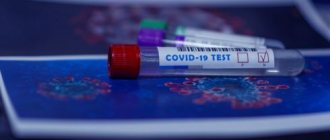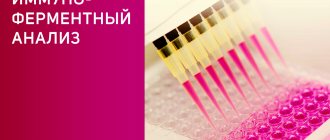MCV in a blood test is one of the most important erythrocyte indices. It reflects the average volume of a red blood cell and is calculated by dividing the hematocrit by the number of red blood cells. The result is expressed in cubic microns or femtoliters.
Another way to obtain this indicator is to multiply the hematocrit by 10 and divide the resulting number by the number of red blood cells contained in one cubic millimeter of blood.
It is important to consider that in some cases the mcv test will produce invalid data. For example, in sickle cell disease, large numbers of abnormal, misshapen red blood cells circulate in the bloodstream. Therefore, the indices obtained by calculation will in this case be uninformative.
When do you need to take a General blood test without leukocyte formula (venous blood)?
- To assess general health (routine medical examinations, screening examinations, etc.);
- For diagnostics at the first stage of a wide range of diseases that may manifest themselves as changes in the characteristics of peripheral blood;
- Diagnosis of anemia, polycythemia along with the study of hemoglobin and hematocrit;
- Monitoring ongoing drug treatment for patients suffering from bleeding or chronic anemia;
- Determination of the activity of erythrocyte formation processes in the bone marrow.
What is the norm and what is considered a deviation
A normal value is considered when the MCV is between 80 and 100 femtoliters. The red blood cell in this case is a normocyte.
If the average volume of a red cell is less than 80 fl, it is a microcyte. Well, if the volume is more than 100, then such an erythrocyte is called a macrocyte.
Accordingly, microcytosis is distinguished when a large number of microcytes are detected in the blood. Low hemoglobin is characteristic. Macrocytosis is characterized by an increased content of macrocytes in the analysis.
Anisocytosis is the presence of red blood cells of different sizes and shapes.
In newborns and children under one year old, the norm is 70-110 femtoliters. With age, this indicator is compared with that of adults
Detailed description of the study
Blood is a multicomponent structure that is part of the internal environment of the body. It consists of plasma, which contains a suspension of formed elements - red blood cells, platelets, leukocytes and some others. This study is carried out to assess quantitative blood parameters. During a general blood test, the number of blood cells and cells of different types is determined, which gives an idea of their functioning, and, accordingly, the state of the body.
During a general blood test (CBC) without a leukocyte formula, the following parameters are assessed:
- number of leukocytes (white blood cells, WBC);
- number of red blood cells (RBC);
- hemoglobin level (hemoglobin content, Hb);
- hematocrit (hematocrit, Hct);
- mean erythrocyte volume (MCV);
- average hemoglobin content in erythrocytes (MCH);
- mean erythrocyte hemoglobin concentration (MCHC);
- platelets (platelet count, PC).
The main indicators that are included in the table of results of a general blood test:
Leukocytes (WBC, White Blood Cells)
Leukocytes, also called white blood cells or white blood cells, are a population of diverse but keyly similar immune system cells that are produced in the bone marrow. They are capable of active movement, capture and absorption of foreign particles and cells of their own body. In the first case, leukocytes provide protection from microbes and other foreign particles, in the second - maintaining the constancy of the internal environment of the body, ensuring the timely destruction of old or defective cells of the body's own.
Their number increases in the presence of inflammation - the degree of increase in the number of leukocytes indicates the severity of the infectious process. CBC allows you to estimate only the total number of leukocytes. In order to assess the population composition, structure and structure of leukocytes, it is necessary to additionally undergo a leukocyte formula analysis. If a general blood test shows abnormalities, the doctor may prescribe a more detailed option.
You can also take a blood test with leukocyte formula and ESR at the Hemotest Laboratory.
Hemoglobin (Hb, Hemoglobin)
Hemoglobin is a protein that contains iron. Its main function is to transport oxygen to cells and remove carbon dioxide from them. The normal limits for it are well known, which vary somewhat depending on gender and age: in men, its content is, on average, higher than in women, and in children of the first year of life, a slight decrease in its content in the blood is normal. The combination of iron in hemoglobin with oxygen gives the blood a bright scarlet hue.
A decrease in hemoglobin levels beyond normal values is one of the types of anemia. This disease is also called “anemia”. There are several types of anemia depending on the causes, but with any of them the amount of hemoglobin per unit volume of blood will be reduced.
The most common cause of anemia is iron deficiency in the diet. In addition, anemia can occur due to blood loss and impaired absorption of iron in the gastrointestinal tract. The cause may also be too intense destruction of erythrocytes (red blood cells) or disruption of their formation. To clarify the diagnosis, additional tests will be required. A complete blood count can be a starting point in the diagnosis and treatment of anemia.
Hematocrit (Ht, Hematocrit)
Hematocrit is a numerical indicator of the ratio of the volume of blood cells, 99% of which are red blood cells, to the total blood volume. However, the statement is true only in cases where the size of red blood cells is normal. If the number of normal-sized red blood cells increases, the hematocrit also increases. In cases of large or small red blood cells, this is not always the case. For example, with iron deficiency, red blood cells decrease and the hematocrit will be reduced, but the number of red blood cells per unit of blood may be normal or even slightly higher.
Hematocrit increases with dehydration, lung and heart diseases, and while in high mountains. On the contrary, a decrease in hematocrit is observed with anemia of various origins, with liver diseases, with the consumption of large amounts of fluid or the administration of large volumes of fluid intravenously.
Red blood cells (RBC, Red Blood Cells)
Erythrocytes (red blood cells) are the formed elements of blood, not entirely correctly called “cells”. They are indeed formed from precursor cells, but upon maturation they lose their nucleus - one of the key features of a living cell. In this way, they provide themselves with the opportunity to implement a highly specialized function: transporting oxygen to the cells of the body and removing carbon dioxide from them. These are the most numerous formed elements of blood, which have the shape of a biconcave disc. Their entire volume is occupied by hemoglobin in order to effectively transport oxygen to cells and remove carbon dioxide and metabolic products from them.
The number of red blood cells is a very important indicator of health. CBC allows you to identify deviations from the norm and prescribe additional studies to clarify the diagnosis and identify the causes of changes in the number of red blood cells, including:
Erythropoietin is a hormone that is synthesized in the kidneys and stimulates the formation and maturation of red blood cells. With a lack of oxygen - hypoxia, it is synthesized more intensely. The number of red blood cells may decrease due to a lack of this hormone.
Vitamin B12, folic acid and sufficient iron are necessary components for adequate hemoglobin synthesis and red blood cell formation.
Red blood cells live in the bloodstream for 120 days, after which they are destroyed in the spleen. Excessive destruction of red blood cells can also lead to a decrease in their number. Determining the number of red blood cells, together with assessing the hemoglobin content, establishing hematocrit and characterizing red blood cells, makes it possible to diagnose the type of anemia and its causes with a high degree of probability. Based on this data, it is possible to select the most effective treatment.
Color Index (CPU)
The numerical indicator of hemoglobin saturation of red blood cells indicates the amount of hemoglobin per red blood cell.
MCH (Mean Cell Hemoglobin, average hemoglobin content in red blood cells)
Numerical expression of the average hemoglobin content in one red blood cell. Together with MCV it is used for the differential diagnosis of anemia.
MCV (Mean Cell volume, average volume of red blood cells)
Numerical indicator of the average volume of red blood cells. Normally it has no diagnostic significance, but is necessary for the differential diagnosis of anemia in combination with MCH.
If the range of red blood cell volumes is large, or there are many red blood cells of a changed shape, then averaging the indicator will not be so informative, but differences in the size and structure of red blood cells indicate the need to pay close attention to this: this is not the norm.
MCHC (Mean Cell Hemoglobin Concentration, mean hemoglobin concentration in red blood cells)
An indicator that shows the average concentration of hemoglobin in red blood cells. A sensitive indicator of changes in hemoglobin synthesis processes - a possible cause of iron deficiency anemia, thalassemia, and some hemoglobinopathies.
Platelets (PLT, Platelets)
Platelets are the formed elements of blood. Like red blood cells, they are formed from precursor cells, but they are not cells: they do not have a nucleus or other important intracellular structures, so their lifespan is only about a week.
The loss of cellular characteristics is due to the high specialization of these formed elements: almost their entire volume is filled with granules, which contain substances involved in the processes of blood coagulation and platelet aggregation. With the help of special receptors, platelets detect a violation of the integrity of blood vessels, form a clot there and stimulate local blood clotting to stop bleeding.
An increase in the number of platelets can occur as a result of taking certain medications, indirectly indicating malignant neoplasms, some inflammatory and infectious diseases. Some types of cancer, malaria and bronchial asthma can reduce their levels. Their levels may also be reduced as a result of disruption of their formation from progenitor cells in the bone marrow or due to increased consumption during wound healing.
The main symptom of a low platelet level is bleeding, up to life-threatening conditions: from the appearance of bruises even with light pressure and bleeding gums, to internal hemorrhages.
Preparing for analysis
In most cases, blood for analysis is taken from a vein. It is permissible to take capillary blood from children under 3 years of age and from adults for special indications. The analysis is taken in the morning, on an empty stomach; the fasting period should be at least 8 hours.
Before blood sampling, it is forbidden to eat food or any drinks; you can drink plain water. There is no need to follow a diet a few days before the test, but you should exclude alcoholic drinks and fatty foods. It is undesirable to be exposed to high physical and psycho-emotional stress, which may affect the reliability of the analysis results.
In the process of preparing for the blood sampling procedure, the patient should be warned about possible unpleasant sensations when applying a tourniquet and during vein puncture.
Red blood cells and their function in the body
Red blood cells are a cellular unit of blood, the main purpose of which is to saturate the body with all components of the inhaled air. They carry oxygen molecules from lung tissue to internal organs, as well as other parts of the body.
In the opposite direction, red cells remove carbon dioxide from the body, formed after absorbing air. Oxygen delivery is carried out by hemoglobin proteins, which make up 98% of the total mass of protein compounds in red blood cells.
When hemoglobin concentration decreases, the transport function of blood cells is disrupted. Therefore, these indicators must be constantly monitored.
A little about anisocytosis
Anisocytosis is the presence of red blood cells of different sizes in the blood - from microcytes to macrocytes. Quantitatively, the distribution of red blood cells by volume is expressed in a special index, designated RDW.
This is what the distribution width of erythrocytes by volume curve looks like in the analysis
Red blood cell heterogeneity by volume (RDW) shows the deviation from the standard volume, expressed as a percentage.
Anisocytosis can be determined by a blood smear under a microscope, but the exact characteristics of these indicators are obtained using hematological analyzers. Interpretation of the results is carried out by laboratory diagnostic doctors together with MCV and facilitates the diagnosis of anemia.
Normally, the width of the distribution of red blood cells is 11.5-14 percent. You should know that if MCV is reduced with normal RDW, then this is typical for blood transfusion, removed spleen, and thalassemia.
If MCV is elevated with normal RDW, then most likely there is liver pathology. If RDW is elevated and MCV is below normal, beta thalassemia, iron deficiency, or red blood cell sludge may be suspected.
If suddenly both indicators are higher than normal, then we can assume cold agglutination, vitamin B12 deficiency or impaired absorption. This combination is also typical after a course of chemotherapy for cancer.
When is MCV prescribed and why is it needed?
This analysis has two main goals:
- Differential diagnosis of anemia.
- Determination of water and electrolyte imbalances.
Determination of the MCV indicator is included in the general blood test and does not require special preparation. It is advisable to donate blood on an empty stomach. Capillary blood is used (analysis is taken from a finger).
Prescribed to patients with anemia, metabolic disorders and severe concomitant pathologies.
This analysis can identify the type of water-electrolyte imbalance. Thus, with macrocytosis, hypertonic overhydration is likely, and with microcytosis, hypotonic dehydration is possible. It goes without saying that this is just an auxiliary method that gives us one of the signs of a particular violation.
Why might MCV parameters increase?
In many cases, the deviation of this indicator from acceptable limits means the presence and development of a pathological process, and timely identification of the problem gives a chance for a quick and effective cure. The risk group includes patients who have a hereditary predisposition to blood diseases and people who lead an inactive lifestyle and do not adhere to proper nutrition.
There are other reasons that lead to an increase in the average volume of red blood cells. These include:
- intoxication with medications - antibiotics, sulfonamides, etc.;
- anemia that develops as a result of significant blood loss and death of red blood cells;
- food poisoning, infectious diseases of the gastrointestinal tract, liver pathologies;
- autoimmune diseases characterized by changes in cellular development;
- decreased quality of functioning of the thyroid gland due to iodine and iron deficiency;
- hormonal imbalance caused by taking contraceptives made on the basis of hormones;
- endocrine disease - myxedema and various bone marrow pathologies;
- activities in hazardous industries, leading to constant contact with poisons and toxins.
Ultrasound of the hepatobiliary system
An increase in MCV levels may be associated with a lack of vitamin B12 due to a lack of cobalt-containing substances in the body. In this case, the proportion of red blood cells decreases, but their size increases significantly.
A slight increase in values may be observed in heavy smokers. Alcohol abuse, as a rule, always provokes the occurrence of macrocytosis, but hemoglobin levels remain unchanged and do not leave the normal range.
This feature in laboratory tests always makes it possible to diagnose alcoholism. Macrocytosis caused by a similar factor is a reversible process, and after approximately 2 months of abstaining from consuming alcohol-containing products, the MCV indicator returns to normal.
Reference! Some experts believe that taking antidepressants can increase the average volume of red blood cells, but so far this assumption has no conclusive evidence.
An increase in MCV is usually characterized by certain symptoms, such as general pallor, rapid heartbeat, which can be detected even at rest. Patients also voice complaints of abdominal pain of unknown etiology, and they experience slight jaundice of the skin, especially the nasolabial triangle. Such signs are a reason to visit a doctor and get a blood test.
Normal MCV values in adults
Causes of elevated MCV
The average volume of red cells is increased when:
- liver diseases;
- hemolytic anemia;
- development of water-electrolyte imbalance in the form of hypotonic overhydration, which is possible with kidney diseases;
- macrocytic and megaloblastic anemia;
- deficiency of folic acid and vitamin B12;
- myelodysplastic syndrome.
Anemia cannot be ruled out when MCV is not higher than normal. For example:
- after bleeding;
- with hemolytic anemia;
- for some acute poisonings.








